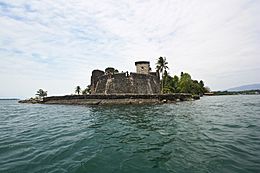Castle of San Felipe de Lara facts for kids
Quick facts for kids Castillo de San Felipe de Lara |
|
|---|---|
| Izabal, Guatemala | |
 |
|
| Coordinates | 15°38′15″N 88°59′36″W / 15.63742°N 88.99338°W |
| Type | Redoubt |
| Site information | |
| Controlled by | INGUAT |
| Open to the public |
Yes |
| Condition | Restored (1955) |
| Site history | |
| Built | 1644 |
| Events | Piracy in the Caribbean |
The Castle of San Felipe de Lara (also known as the Castillo de San Felipe) is an old Spanish fort. It is located in eastern Guatemala, right at the entrance to Lake Izabal. This lake is connected to the Caribbean Sea by the Dulce River. The fort was built in a very smart spot. It was placed at the narrowest part of the river. The Spanish used the Castillo de San Felipe for many centuries. During this time, pirates often attacked and damaged it.
This fort is considered a special historical place by UNESCO. It is also a popular spot for tourists to visit.
Visiting the Castle
The Castle of San Felipe de Lara was added to the UNESCO World Heritage Tentative List in 2002. This means it is being considered for official World Heritage status. The Guatemalan Institute of Tourism (INGUAT) takes care of the fort. It is one of the most popular places to visit in the Río Dulce National Park.
Many people visited the fort between 2001 and 2003. The number of visitors jumped from about 45,000 in 2001 to over 156,000 in 2003. Most of these visitors were from Guatemala.
The fort was damaged by an earthquake in 1999. It got several cracks in its walls. Also, the river water around the fort has some pollution.
Castle History
The area where San Felipe Castle stands has been lived in for a very long time. People lived there even before the Spanish arrived in the mid-1500s.
The Castillo de San Felipe was built to protect the port of San Antonio de las Bodegas. This port was on the south shore of Lake Izabal. It was often attacked by pirates, mostly from England. At night, a large chain was stretched across the river. This chain went from the fort to the other side. It stopped ships from entering the lake.
San Antonio was a very important port. It received Spanish ships carrying goods for the main Spanish government in Guatemala. This port also supplied the fort with soldiers and supplies. Records show that captains were in charge of the fort even into the 1700s. Sometimes, local groups, like the Mosquito Zambo, raided the area. This caused people to leave or be taken away. Because of this, many towns near the lake became empty. In 1776, a count showed 122 people living at San Felipe. They were either Spanish or of mixed background. By 1797, there were 36 soldiers guarding the fort.
Building the Fort
There was already a tower on this spot by 1604, but it was destroyed. The main fort was built in 1644. This was ordered by Diego de Avendaño, who was the governor of Guatemala at the time. Back then, it was called Fuerte Bustamente or the Torreón de Defensa (Defense Tower).
A high judge named Lara y Mogrovejo helped change the design of the walls. This is where the "de Lara" part of the name comes from. The fort was rebuilt in 1651 under his orders. In 1687, a new design was made by Diego Gómez de Ocampo. He used ideas from a famous French military architect. This new design was put into place in 1689. By 1697, the fort had three strong defense areas. These were called Nuestra Señora de Concepción, Nuestra Señora de Regla, and the San Felipe Keep.
More defenses were added in 1797. These included three areas for cannons, known as the San Carlos, San Felipe, and Santiago batteries. Two barracks, which are buildings for soldiers, were also added. They were called Buenavista and Santiago.
Fort Layout
The fort has a rounded defense area in the front. Behind it are two outer walls that meet in the middle. Each wall ends in a square tower. The fort has three levels. To get to the fort from the land, you had to cross a moat. This moat had a drawbridge that could be pulled up.
See also
 In Spanish: Castillo de San Felipe de Lara para niños
In Spanish: Castillo de San Felipe de Lara para niños


